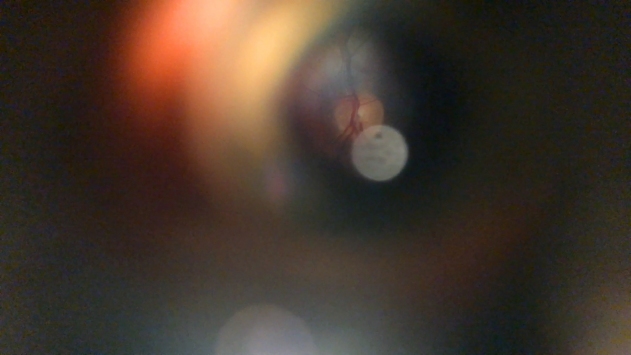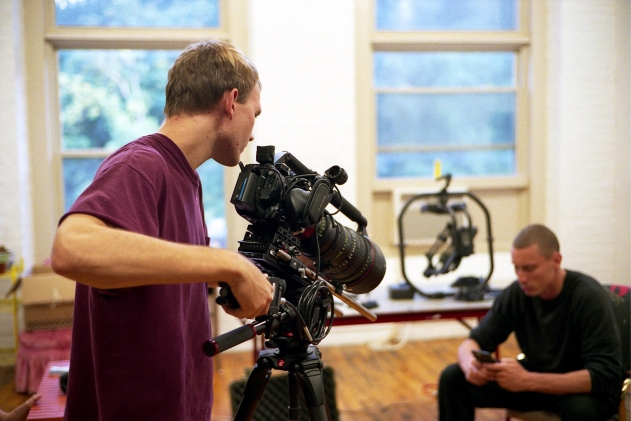
ALL LIGHT, EVERYWHERE is an essay film exploring the interrelated histories of camera technology and weaponry. Directed by Theo Anthony (RAT FILM), the documentary made its world premiere at Sundance in 2021 and will open in theaters on June 4. On June 3, the Queens Drive-In will present a special advanced screening with Anthony in person. We spoke with him about the scope of the film and its foundational ideas.
Science & Film: You open ALL LIGHT, EVERYWHERE with a very poetic framing: the similarities between what the eye ignores by virtue of how the optic nerve works and what the camera leaves out of its representations. Is that always how you intended to frame this film?
Theo Anthony: We actually had an entirely different introduction to the film. I was reading this book Techniques of the Observer by Jonathan Crary—one of the founding texts of this film. He writes about extromission theory and this ancient theory of light in which we all contain an “ocular fire.” The light emanates out the front of our eyes and connects with shells of representation. I found that idea of projectile vision really rhyming with the projectile of the weapon, where seeing is this targeted act. I was thinking about the ways in which the act of targeting is an act of violence even before the trigger is pulled.
The film’s title, ALL LIGHT, EVERYWHERE, comes from a ninth century Persian philosopher Avicenna who translated Plato and integrated it with Islam. He wrote about light being this binding force and all light everywhere tying the world together. I thought that was a beautiful image of light as this thing that enables us to see, ties us together, and takes on a very different significance when talking about surveillance. So that was the original opening to the film, and it was a bit too heavy too soon [laughs]. It was almost a parody of itself—opening with a super serious image and quoting Plato. You’ve just got to take a step back and ask, why am I starting with Plato? Jonathan Crary writes about the blind spot occluding the world. It was a way of grounding [the film] in my own body and not making it some cerebral exercise.

Still from ALL LIGHT, EVERYWHERE
S&F: It must have been a huge job to figure out the scope of this film and edit it down. Was there a guiding principle that you worked with in terms of deciding what would fit in?
TA: The project was four and a half years start to finish. We knew we were going to focus on violence outside the frame and not show explicit images of violence. Our strategy wasn’t to re-traumatize audiences for the sake of proving a traumatizing event happened or is still happening. We were conscious to not speak for other people, especially marginalized people’s experiences, and to understand my own perspective as a white, male filmmaker. That privilege doesn’t grant me access to know the ins and outs of everyone’s personal lives and I can’t come in with an air of authority and translate the experience of being under surveillance. But what that privilege does give me access to is to some of these policing institutions that are more willing to trust me and let me into those spaces. Linked with that is this idea of opacity based off of the work of Martinique writer Édouard Glissant. We don’t have a right to full transparency at all times. So in the film we were always confronting this idea of what to show, and more than that what not to show. I think you see that in the ending.
S&F: Can you speak a little more about the ending and that choice to let us into that process of what you decided not to show?
TA: We were making a film that spoke to the very particular threat of violence in image-making and we always wanted to acknowledge that there were these other histories present. The camera is used by people to figure out their own possibilities and generate their own worlds. We wanted to make sure that joy and possibility was in the film along with oppressive histories. It was the best footage in the film and an amazing experience, we fostered an amazing relationship with the kids, and also tried to make sure that they were getting something out of our experience—we were always lending equipment and hiring them to work on the film.
With all that said, we got to the edit of the film, and the footage was doing those things in isolation, but cinema theory 101 is montage: Image A next to Image B, you’re going to assume that Image A is associated with Image B. When you have an image of black teenagers at the other end of a shot of technology that is primarily aimed at young black people in this country, as an audience we are trained to see those people as targets, and that wasn’t a framing we were interested in perpetuating. The decision to leave it in at the very end was to point to the handling of the material and those decisions, to have that presence of the conversation that was had which shaped the whole structure of the film.

Cinematographer Corey Hughes and director Theo Anthony
S&F: You found this perfect company, Axon, that, in making body cams and tasers embodies a lot of the things you’re saying in the film. What did you tell them before filming?
TA: In almost every single instance when I’m planning a shoot, I do months and months of research and it’s like a narrative shoot—we have a shot list, questions, we storyboard, and we’re always hitting our marks. We design it in a way to leave open some room for improvisation, but I really try to make sure there’s a structure and to be explicit about boundaries. I include that person in on the conversation of what the image will be. With Steve [of Axon], we watched every single interview he had ever done, every single media tour, and everything that he did in our film he had done before in almost exactly the same way using almost exactly the same words. When we were working with him, rather than try and sculpt something new, we did something we knew he’d be comfortable with. We actually wanted to lean into that performance because we felt that performance was the clearest inditement of the ideas we were trying to present. Steve is a nice guy who really accommodated us. He represents a company deeply involved in a horrible, inhumane system. Understanding how perfectly fine, nice people can be involved in these systems is the much more important and difficult task. It was important to us to allow both sides: you see someone eager to please us and at the same time he’s saying these things and you’re just like, man, do you hear what you’re saying?
♦
ALL LIGHT, EVERYWHERE is written, directed, and edited by Theo Anthony. It is produced by Riel Roch-Decter, Sebastian Pardo, and Jonna McKone. Dan Deacon did the music. The film opens in theaters in New York and LA on June 4.
TOPICS